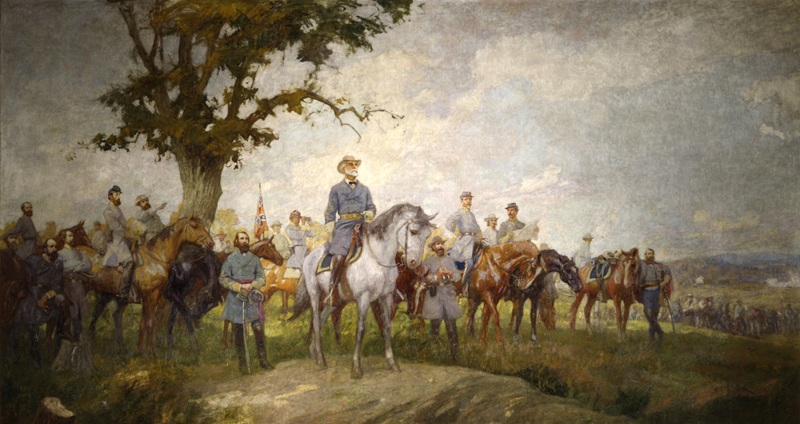VHS Memorial Military Murals
VHS Memorial Military Murals
By: Alexis Leon

Almost half a century after the epic clash between North and South, the aging veterans of the American Civil War sought to have their respective causes commemorated and honored.
Following the construction of Gen. Ulysses S. Grant’s tomb in New York, members of the Confederate Memorial Association (CMA) wanted the Lost Cause of the South to be memorialized with just as much dignity and grandeur as Union veterans gave to Grant’s tomb and to the planning and construction of the Lincoln Memorial in Washington, D.C..
With an especially poignant case being made by J. T. Ellyson, Virginia’s lieutenant governor and CMA president, southern veterans in 1896 commissioned the design and building of the Confederate Memorial Institute in Richmond, Virginia. Sixteen years after the establishment of the CMA, construction began on land donated from the R. E. Lee Camp of Confederate Veterans. This building became known as Battle Abbey.
With the intention of depicting the Confederacy’s greatness and of establishing a legacy that would live on long after the aging veterans passed, the CMA chose Charles Hoffbauer, a French painter, to compose the Memorial Military Murals, an all-encompassing portrayal in four large paintings of the Confederate experience during the Civil War.
Hoffbauer began the large-scale oil works in 1913. He painted directly onto canvas nailed to the walls of the mural gallery in Battle Abbey, which is now part of the Virginia Historical Society (VHS). (The VHS absorbed the Confederate Memorial Association in 1946.)
Dr. William M. S. Rasmussen, VHS lead curator, notes that the CMA commissioned Hoffbauer at the peak of his career and that the Military Memorial Murals were his crowning achievement.
Guided by Ellyson and Douglas Southall Freeman, the Pulitzer Prize–winning biographer of Robert E. Lee, Hoffbauer was able to grasp and ultimately portray the stoic pride of the South by depicting all branches of the Confederate service, including the artillery, infantry, cavalry, navy, and the marines, while also including the Confederacy’s top officers.
The murals were realized, but not without challenges. In 1914, just a year after starting his work, Hoffbauer left Richmond to fight for his native France during the First World War. After the conflict, Hoffbauer returned to Richmond. Having experienced war firsthand, he decided to start over with the murals. He pried his original work off the walls with a pallet knife and began again. Hoffbauer still managed to complete the murals by 1920, after essentially starting from scratch.
Hoffbauer, who always dreamed of becoming a historical painter, envisioned his paintings to be something of a visual written record.
But his illustrated account of historic greatness has been decaying over the last century. The magnificent detail of Hoffbauer’s paintings was slowly covered by dust, dirt, and soot emitted from a coal-burning furnace. Initial attempts to restore the murals began soon after the furnace was replaced in 1956, but significant damage was already done.
A renewed attempt to restore the murals began in 2011 after the VHS, a private nonprofit, received funding from the Save America’s Treasures (SAT) grant in the amount of $375,000 awarded by the National Park Service and the National Endowment for the Arts. Through private support, the VHS matched the SAT grant with an impressive $381,000, giving Cleo Mullins, lead conservator of the Restoring the Hoffbauer Murals project, and her team the financial support needed to take on this massive project.
“When he came here, he had one idea about heroic war paintings but when he came back from WWI he had to change them because he had an entirely different perspective of what war was,” said Mullins.
Rasmussen asserts that the murals hold a heavy historical significance, and they are the most important large-scale paintings in the South.
“The purpose of the murals was to show how much the South suffered during the war,” said Rasmussen.
“These murals,” confirms Mullins, “are more like an archive than an art depository.”
The Hoffbauer Military Memorial Murals are considered one of the greatest depictions of Confederate experience because of their artistic magnificence and their historic portrayal of the struggles, tragedy, and bravery of the Confederacy.
The Military Memorial Murals can be viewed for free at the Virginia Historical Society seven days a week. If you would like more information on this project, please visit www.vahistorical.org/hoffbauer/.


